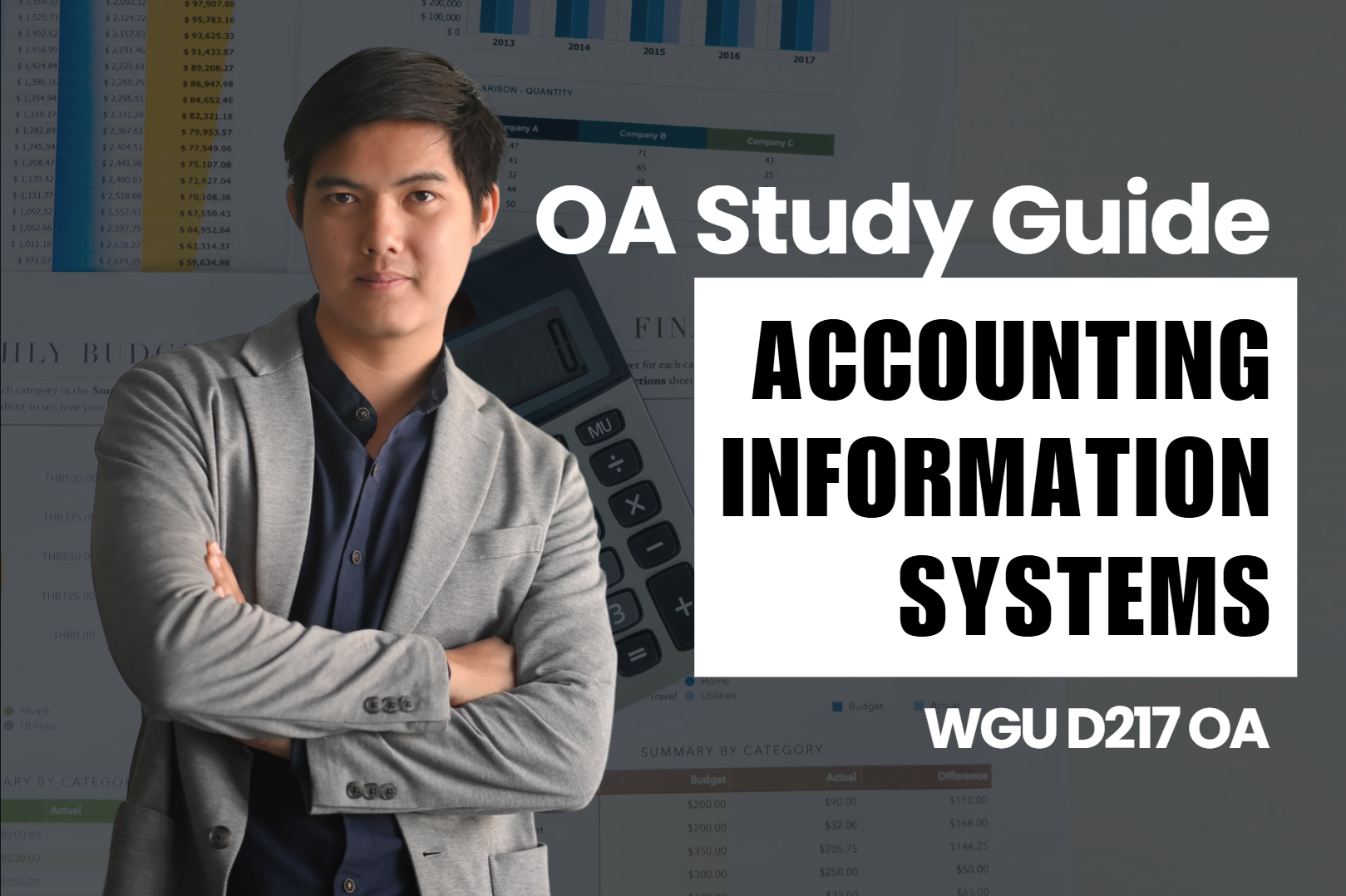WGU D217 OA Study Guide - 2025 | Cracking the Code of Corporate Accountability📖
All prospective financial masters along with audit professionals should fasten their seatbelts. Every business owner’s obsession with numbers, auditing, and regulatory compliance has always puzzled curious observers. Corporate accountability brings together executives who feel pressure from SOX while financial systems handle important tasks under the watch of both internal and external auditors who perform financial detection.
This article explores key financial regulations, reporting systems, and auditing distinctions:
- Key Requirements Under SOX Sections 302 and 404: Section 302 requires executives to certify financial reports’ accuracy, while Section 404 mandates internal control assessments by management and auditors to ensure compliance and prevent fraud.
- Operational Features of GLS, FRS, and MRS: The General Ledger System (GLS) records financial transactions, the Financial Reporting System (FRS) compiles financial statements, and the Management Reporting System (MRS) provides internal reports for decision-making.
- Differences Between External and Internal Auditing: External auditing ensures financial statements comply with regulations, while internal auditing focuses on improving internal processes, risk management, and operational efficiency.
Following this lesson you will comprehend the importance of both SOX compliance and general ledger concepts instead of simply using them professionally. WGU D217 provides all the necessary information to respond to the questions that drive successful business operations. 🚀
How to Use This Guide for the WGU D217 OA Exam? 📖
The D217 Accounting Information Systems OA exam at WGU evaluates your understanding of regulatory compliance, financial reporting systems, and auditing practices. This guide simplifies the key concepts of the key requirements for management and auditors under Sections 302 and 404 of the Sarbanes-Oxley Act (SOX), the operational features of the general ledger system (GLS), financial reporting system (FRS), and management reporting system (MRS), and the differences between external auditing and internal auditing to help you grasp the topics tested in the exam.
We also provide exam-style questions and practical applications to ensure you’re fully prepared for the questions on the WGU D217 OA exam.

Key Requirements for Management and Auditors Under Sections 302 and 404 of the Sarbanes-Oxley Act (SOX) For D217 OA📝
Sarbanes-Oxley Act (SOX) stands for the enhanced law that is applicable to the United States to maintain corporate governance and realistic financial results. Two sections of SOX are – Section 302 and Section 404 which contain specific standards that management and auditors need to adhere to these principles. Claiming that it is quite easy to comprehend these requirements, let us split them into several categories.
Section 302: Corporate Responsibility for Financial Reports
Section 302 ensures that top executives like the CEO and CFO are personally accountable for their company’s financial reports. This section is all about making sure that the people in charge are taking responsibility for the accuracy and honesty of the information they share.
Key Requirements of Section 302:
- Certification of Financial Reports:
- The CEO and CFO must officially confirm that they have reviewed the financial reports.
- They must declare that these reports are accurate, and complete, and do not mislead investors.
- Internal Controls:
- Executives are responsible for setting up and maintaining systems, called internal controls, to make sure financial reports are accurate.
- These controls need to be reviewed within 90 days before submitting the reports.
- Disclosure of Issues:
- If there are significant problems or weaknesses in these internal controls, executives must inform the auditors and the audit committee.
- They must also report any cases of fraud involving management or employees who play a big role in these controls.
- Changes in Internal Controls:
- Executives must disclose any major changes made to the internal controls, especially actions taken to fix problems.
- Executives must disclose any major changes made to the internal controls, especially actions taken to fix problems.
- Sub-certifications:
- There are detailed certifications that outline additional responsibilities for internal controls, ensuring thorough checks.
In short, Section 302 holds the CEO and CFO accountable for ensuring that their company’s financial statements are truthful and supported by strong internal processes.
Section 404: Management Assessment of Internal Controls
While Section 302 is more about the responsibility of executives, Section 404 is about building a dependable system of reporting financial information. This way it confirms to a company that its internal controls are proper and efficient to control its operations.
Key Requirements of Section 404:
- Management’s Assessment:
- Management must conduct an annual review to determine if internal controls are working properly.
- This assessment is documented and included in the company’s yearly report.
- Role of External Auditors:
- Independent auditors must evaluate and verify management’s assessment of internal controls.
- This adds credibility to the report and ensures the checks are not biased.
- Reporting Framework:
- Companies need to use a standardized method, like the COSO framework, to assess their internal controls. This ensures consistency and reliability.
- Companies need to use a standardized method, like the COSO framework, to assess their internal controls. This ensures consistency and reliability.
- Fixing Deficiencies:
- If any problems are found, management must fix them quickly and document the solutions.
Section 404 emphasizes transparency by requiring a systematic evaluation of how well internal controls are functioning and involving external auditors to verify the results.
Comparing Section 302 and Section 404
While both sections aim to improve corporate accountability, they have distinct focuses:
- Section 302 is about executive accountability, ensuring that CEOs and CFOs personally confirm the accuracy of financial reports.
- Section 404 emphasizes a systematic review of internal controls, ensuring that the systems themselves are reliable.
Let’s look at a simple comparison:
Aspect | Section 302 | Section 404 |
Purpose | Certification of financial reports | Assessment of internal controls |
Who is Responsible | CEO and CFO | Management with auditor verification |
Frequency | Quarterly (10-Q filings) | Annually (10-K filings) |
Scope | Financial statement accuracy | Internal control effectiveness |
Audit Involvement | Not required | External audit required |
Why These Sections Matter For D217 OA
Sections 302 and 404 play a key role in preventing financial scandals and protecting investors. By holding executives accountable and ensuring strong internal controls, these sections create trust in a company’s financial practices. Understanding these rules helps future accountants and auditors ensure businesses operate ethically and transparently.
By mastering topics like SOX 302 and 404 in the WGU D217 module, students can gain valuable insights into corporate governance. These concepts also address some key questions in the module’s assessments, making it easier for students to navigate the WGU D217 OA and other challenges in the course. Whether you aim to manage financial systems or become an auditor, understanding these principles is essential for success in accounting and finance.
Building on the accountability established by SOX Sections 302 and 404, let’s explore the operational features of the systems that power financial reporting and decision-making within organizations: GLS, FRS, and MRS.
Operational Features of the General Ledger System (GLS), Financial Reporting System (FRS), and Management Reporting System (MRS) For D217 OA 📝
Organizations rely on effective accounting systems to manage their operational and financial data in the present day. General Ledger System (GLS), Financial Reporting System (FRS), and Management Reporting System (MRS) form the three levels of accounting systems. Each system operates differently when it comes to financial management and decision-processing responsibilities. Each system can be examined individually for review.
General Ledger System (GLS)
The General Ledger System (GLS) is the database that contains all financial transactions. Hence it serves as the basis of financial reporting since it reflects and is instrumental in maintaining accountability of business transactions.
Key Features of GLS:
- Recording Transactions:
- GLS records all financial transactions, such as sales, purchases, and payments.
- Each transaction is classified under specific accounts, which are part of a structured chart of accounts.
- Double-Entry Accounting:
- Every transaction is recorded in two accounts: a debit and a credit. This ensures the accounting equation (Assets = Liabilities + Equity) is always balanced.
- Reconciliation Processes:
- GLS enables the reconciliation of bank statements and subsidiary ledgers to ensure data accuracy.
- Regular reconciliations help identify and correct discrepancies early.
- Access Controls:
- Security features in GLS prevent unauthorized access, ensuring that sensitive financial data remains secure.
Financial Reporting System (FRS)
The Financial Reporting System (FRS) completes data collection of the GLS to come up with filings in compliance with the/accounting standards necessary to prepare financial statements. This is recommended when reporting a company’s financial position to other people or organizations outside the company.
Key Features of FRS:
- Report Generation:
- FRS automates the creation of standard financial reports, such as balance sheets, income statements, and cash flow statements.
- Compliance with Standards:
- Ensures that reports adhere to accounting standards like GAAP or IFRS, providing consistency and transparency.
- Data Visualization:
- Modern FRS tools include dashboards that present financial data visually, making it easier to interpret trends and metrics.
- Audit Trails:
- Tracks changes and updates to financial reports, providing accountability and aiding external audits.
Management Reporting System (MRS)
Whereas the Management Reporting System (MRS) targets internal decision-making by providing organizational management with customized reports. These are more sophisticated and may contain more qualitative data as well as quantitative numbers not normally included in a standard set of financial statements.
Key Features of MRS:
- Key Performance Indicators (KPIs):
- MRS tracks performance metrics like sales growth, profit margins, and employee productivity to help management evaluate business operations.
- Scenario Planning Tools:
- Enables management to simulate different business scenarios and assess potential outcomes, supporting proactive decision-making.
- Real-Time Data Access:
- Provides up-to-date information, ensuring timely and informed decisions.
- Integration with Other Systems:
- MRS can pull data from various sources, including GLS and operational systems, to create comprehensive reports.
Differences Between GLS, FRS, and MRS
While these systems are interconnected, they serve different purposes and users:
Feature | General Ledger System (GLS) | Financial Reporting System (FRS) | Management Reporting System (MRS) |
Primary Purpose | Record financial transactions | Generate standardized financial statements | Provide tailored reports for decision-making |
Users | Accountants and financial staff | External stakeholders like investors | Internal users like managers |
Regulatory Focus | Ensures accurate record-keeping | Compliance with GAAP/IFRS | Not regulated; focuses on internal use |
Report Frequency | Continuous | Periodic (e.g., quarterly, annually) | As needed (e.g., monthly, weekly) |
How These Systems Work Together
- GLS acts as the central hub, recording all transactions and feeding data into FRS and MRS.
- FRS uses this data to produce standardized reports for external communication.
- MRS utilizes data from GLS and FRS to generate detailed, actionable insights for internal management.
Importance For D217 OA
Understanding the operational features of GLS, FRS, and MRS helps students grasp the interconnectedness of accounting systems. Mastery of these concepts not only prepares them for the WGU D217 OA questions but also equips them with the knowledge to manage real-world financial systems effectively. By leveraging these systems, organizations can ensure accuracy, transparency, and strategic decision-making in their operations.
Tired of reading blog articles?
Let’s Watch Our Free WGU D217 Practice Questions Video Below!

Differences Between External Auditing and Internal Auditing For D217 OA📝
Auditing is a critical process for organizations to ensure accuracy, transparency, and efficiency in their operations. External and internal auditing serve distinct purposes, each vital to the organization’s governance and performance. Let’s explore their differences in a comprehensive and conversational manner.
What is External Auditing?
External auditing is when two different organizations’ professionals examine the former organizations’ financial statements and their legal adhesion. This type of audit is crucial for offering a guarantee to the third party of the company’s sound financial status as presented in financial statements.
External auditors entirely have no connection with the organization which they are auditing. This makes their assessments impartial and free from influence from other parties such as the government. It falls to them to ensure that the financial statements produced are accurate and are in compliance with such standards as GAAP or IFRS. In so doing, external auditors assist in developing a positive image of the organization and reliability of the information disclosed by it.
The result of an external audit is an audit report, which contains an auditor’s opinion on the companies’ financial statements’ correctness and fairness. This report is made available to the outside world such as shareholders and heads of regulatory bodies. In most cases, the external audit is performed once each year, which means this activity is periodic though crucial for public companies. In most cases, external auditors are recognized as CPAs or possess the accreditation of the same from an accredited company.
What is Internal Auditing?
Internal auditing, in contrast, is performed by people of the company. Of course, its primary aim is the analysis of internal activities, risks, and control, as well as the optimization of organizational operations. While external auditing aims at facilitating the preparation of external financial statements, internal auditing is directed at the internal operations of an organization.
Internal auditors are an integral part of the organization but maintain independence from the areas they audit. This separation ensures that they can evaluate processes objectively and recommend improvements without bias. Internal auditing covers a wide range of topics, including compliance with policies, effectiveness of risk management, and operational efficiency. It goes beyond financial data to assess broader organizational performance.
Communications prepared by internal auditors are made available to management personnel or the committee on audit. These reports, therefore, contain possible solutions intended for increasing productivity, managing vulnerabilities, and meeting compliance goals. It can be planned at any given time over a specific period or can run simultaneously throughout the period that is deemed most appropriate for the conducting of internal audits by the organization. The principles are general and achieve flexibility which is important in internal auditing because they can be adjusted toward new business needs.
Comparing External and Internal Auditing
While both external and internal auditing aim to enhance accountability and efficiency, their approaches, purposes, and users differ significantly. The table below highlights the key differences:
Aspect | External Auditing | Internal Auditing |
Independence | Conducted by independent third parties | Conducted by employees within the organization |
Primary Audience | External stakeholders like investors and regulators | Internal stakeholders like management and audit committees |
Purpose | Verify financial statements and ensure compliance | Improve internal processes and manage risks |
Scope | Focused on financial statements | Broader scope including operations and compliance |
Frequency | Typically annual | Ongoing or periodic, based on organizational needs |
Certification | Performed by CPAs or equivalent professionals | Performed by certified internal auditors (e.g., CIA) |
How They Complement Each Other
Each type of audit is crucial for the effective functioning of an organization. External auditing assures third parties outside the organization through a review of financial statements. On the other hand, internal auditing assists an organization in evolving from the inside by pointing out areas requiring enhancement, control risks, noncompliance, and other shortcoming.
For example, the internal audit evidence may be useful to the external auditors concerning the `tone at the top’ in the organization. On the other hand, the results of the external audit could help provide internal auditors with clues as to where more focus is needed by the organization. Altogether, these audits help to form a base for the organizational governance and responsibility system.
Importance For D217 OA
Understanding the differences between external and internal auditing is crucial for students in the WGU D217 module. Mastery of these concepts not only prepares them for the WGU D217 OA questions but also equips them with practical knowledge applicable to real-world scenarios. By recognizing the unique roles these audits play, students can better appreciate their contributions to organizational success and governance.

Mastering WGU D217 OA: Lock in These Concepts for Success! 📄
And there you have it! We’ve journeyed through the world of corporate accountability, decoded the responsibilities of management and auditors under SOX, explored the backbone of financial reporting systems, and uncovered the key differences between internal and external auditing. By now, you should have a solid grasp of these essential concepts—because guess what? They’ll definitely show up in your final OA for WGU D217 OA!
Understanding these topics isn’t just about passing a test (though, let’s be real, that’s pretty important). These principles form the foundation of financial integrity in businesses, and whether you’re crunching numbers, auditing statements, or making big management decisions, this knowledge will serve you well.
So, study up, stay confident, and tackle those WGU D217 OA questions like a pro! You’ve got this! 💪 Best of luck! 🚀






